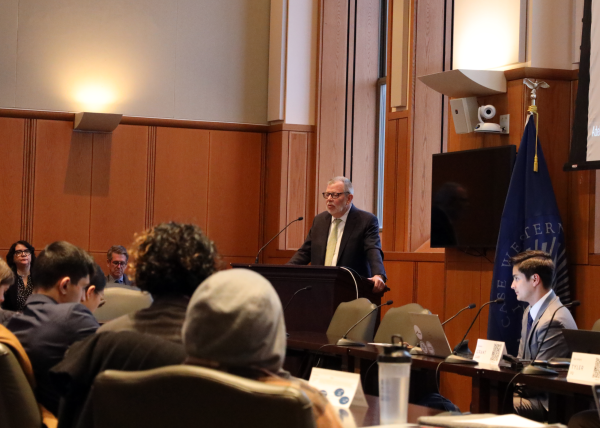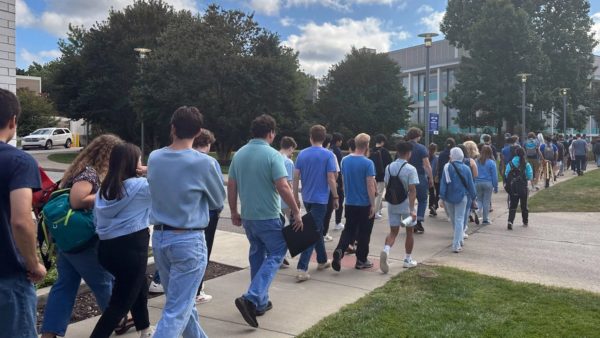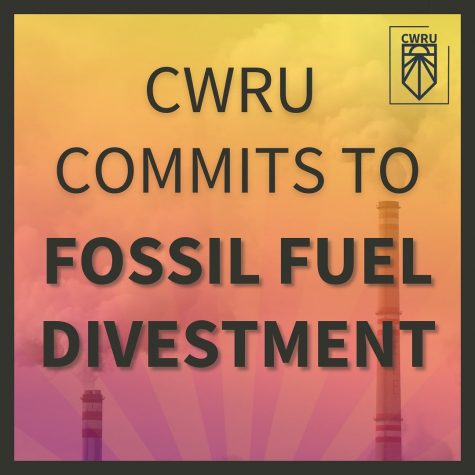Cleveland mayor’s plan to plant trees should improve air quality
October 25, 2019
Air pollution has consistently made Cleveland one of the smoggiest cities in the United States, and earned the Cleveland-Akron-Canton area the number nine spot on the American Lung Association’s “State of the Air 2019” rankings of U.S. cities most plagued by year-around particle pollution. Transportation, heavy industry and coal-fired electricity generation are the main factors causing Cleveland’s continued air pollution. However, a recent announcement by Cleveland Mayor Frank Jackson committed up to $1 million a year for the next ten years to enhance existing steps to reduce air pollution and increase equity.
In the U.S., the Clean Air Act is the framework document governing air quality. The Environmental Protection Agency (EPA)’s Office of Air Quality Planning and Standards (OAQPS) is responsible for the Clean Air Act’s provisions being met. OAQPS also sets, monitors and ensures that national ambient air quality standards (NAAQS) are followed.
Cleveland has improved its air quality in recent years. From 2015 to 2017, Cleveland experienced its lowest particle pollution levels since 2000, when the American Lung Association began publishing yearly reports. Furthermore, Cleveland’s number of high ozone and high particle pollution days each year has dropped consistently since 2000. In 2016, Cleveland had only five high ozone pollution days and three high particle pollution days. Comparatively in 2000, Cleveland had 50 and 35 days of high ozone and high particle pollution, respectively.
Unfortunately, Cuyahoga County remained unable to achieve ozone and particulate NAAQS standards through 2018. Cuyahoga County has been designated as a maintenance zone for carbon monoxide and lead air pollution, which means the county only recently began meeting federal requirements for these types of pollution.
Jackson recently pledged upwards of $1 million a year to plant trees in the city over the next 10 years. This announcement was the culmination of a series of new tree-related policies instituted in the past few years. In 2017, the city began enhancing tree maintenance and dead tree removal and, in 2018, created tree preservation requirements for new development.
Cuyahoga County Executive Armond Budish is pursuing a similar plan at the county level. Budish intends to spend $5 million in five years planting trees. By 2040, the goal is for 30 percent of the city to be covered in tree canopy. Thirty percent canopy coverage is the threshold for a healthy urban canopy. Currently, only 18 percent is covered. According to Matt Gray, chief of sustainability for the city of Cleveland, this means that these trees need to be planted by 2030.
“To get to the 2040 goal, because trees need time to grow, the trees need to be planted by 2030,” said Gray.
Jackson and Budish’s plans to increase spending on planting trees are in coordination with a larger tree coalition. Neither the city nor the county alone has the resources to replant enough trees to achieve the 2040 goal. According to Gray, $80 to $100 million is needed by 2030 to achieve the goal.
Allocating the planting of trees will follow a two-year neighborhood approach. Each neighborhood in Cleveland will spend the first year planning where to plant trees and the second year planting. Three or four neighborhoods will be participating in the planning phase each year and another three or four will be in the planting process.
Gray also noted that part of the funds will be available to residents by request.
“There will be money for residents that request trees,” said Gray.
Motivation for pursuing a policy of replanting trees in the city is based on economics, air pollution and public health.
According to Peter McCall, professor in the department of Earth, environmental and planetary sciences and director of the environmental studies program, “the effects [of planting trees] are immediate, local and manifold, affecting air quality and climate, social cohesion and wildlife.”
The economic benefits of trees are plentiful. Over 50 years, a tree will save approximately $62,000 in air pollution control. Additionally, canopies can reduce air conditioning costs by 30 percent.
Jackson has several other goals for air pollution in Cleveland, including reducing carbon emissions by 80 percent and using entirely renewable energy sources by 2050. To reach these goals, significant steps to addressing air pollution will need to be implemented.
Gray mentioned that solar and wind energies will play a prominent part in Cleveland’s ability to reach these goals.
“Offshore wind is going to be a big piece of [the] pie,” Gray explained.
Increasing energy efficiency will be the most significant pathway to reducing emissions and reaching 100 percent renewable energy. So far, Cleveland has been able to reduce emissions while maintaining economic growth.
Poor air quality is associated with a myriad of health problems. About one third of all deaths from heart disease, lung cancer and strokes can be attributed to poor air quality. Children, the elderly and those with preexisting conditions are especially sensitive to air pollution, but everyone is impacted. Furthermore, over time, exposure to air pollution causes an individual’s immune system to change.
Communities of color and those burdened by high poverty are disproportionately impacted by poor air quality. African Americans, for instance, are at risk for health issues related to air pollution at double the rate of white Americans. Additionally, the schools serving communities of color are often located near highly-trafficked roadways, a major source of air pollution.
The EPA’s fifth region, comprising of Illinois, Indiana, Michigan, Minnesota, Ohio and Wisconsin, has the most unequal distribution of air pollution between whites and African Americans out of all 10 regions.
In Cuyahoga County specifically, McCall notes that indoor pollution from lead paint in older homes is especially pernicious. McCall explained the effects of lead poisoning and the greater impact the heavy metal has on children residing in poorer neighborhoods.
“The inhaled or ingested dust arising from flaking lead paint is a poison that affects development in children, with lifelong consequences,” said McCall. “Blood levels of lead in poor minority children historically confined to the worst housing in the county are several times the levels of children in richer suburban areas.”
Gray confirmed that equity and environmental justice are important considerations in deciding where trees are going to be planted.
“Environmental justice is a big deal,” said Gray. “If you look at tree canopies, trees are not evenly distributed across the city.”
Outside of air pollution’s impact on humans, poor air quality also impacts wildlife.
Emissions of nitrogen oxides from power plants and vehicles cause eutrophication, where algal blooms deplete oxygen in aquatic environments, which causes fish and other oxygen-dependent organisms to die. Lake Erie has been afflicted by frequent algal blooms since the 1990s, which turn the lake’s water a distinct blue-green hue. As recently as this past summer, visitors to Lake Erie have been warned not to allow their dogs to swim in the lake in Erie County, Pennsylvania. Native wildlife was endangered by these algal blooms much like any dog that swam in the lake.
Animals, like humans, also experience health problems, such as birth defects, reproductive failure and disease, from direct exposure to air pollution. Mercury is one such air pollutant that affects wildlife in the Cleveland area, according to McCall.
“Mercury in Lake Erie and other Great Lakes [has caused the population of] fish and birds [to] steadily decrease[d] in the first three decades after the passage of the Clean Air Act in 1970,” McCall stated. “Since 1990 however, the trend has reversed, first in northern Wisconsin and Minnesota, and later in Lakes Erie and Ontario.”
McCall believes this increase in mercury concentrations found in animals is likely a result of climate change. Mercury enters the air as a byproduct of coal combustion in power plants.
Under President Trump, many air quality and emissions standards have been loosened or eliminated. A report conducted by The New York Times, published in September, identified 10 areas where the Trump administration had already rolled back policies addressing air pollution and 14 more policies that the administration was in the process of rolling back.
Among the policies already rolled back, the Trump administration no longer requires oil and gas companies to report methane emissions, began allowing companies to use hydrofluorocarbons, gases that deplete the ozone layer, and eliminated a tailpipe emissions monitoring standard for federal highways. Additionally, in an executive order, Trump dictated that federal agencies will no longer be determining the “social cost of carbon,” an Obama-administration calculation intended to estimate the economic benefits of reducing carbon emissions in the long-term.
McCall finds the changes to air quality programs under the Trump administration egregious.
“Particularly pernicious is the move to change the cost-benefit analysis rules used by the EPA and the unprecedented disbanding of scientific advisory committees to disable the calculation of true benefits of regulation,” said McCall.
McCall also disputes the Trump administration’s argument that environmental regulations are economically detrimental to the U.S.
“The Clean Air Act, for example, is judged by most experts to have benefits to health an order of magnitude greater than the cost to industry of regulation. The political problem is that the benefits in better health are widely shared but indirect and underappreciated.”



















